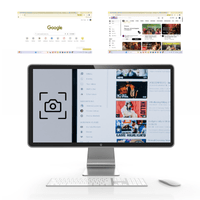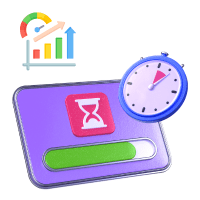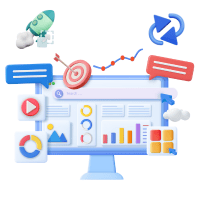
Managing modern projects is a complicated thing to do. According to experts, modern projects need modern management approaches. Simply put, the Agile methodology is one of them. Furthermore, it is not the only option. However, given today’s work world scenario, it is one of the best options for managing projects.
Techniques such as waterfall and others have more chances of failing when it comes to managing modern complex projects. On the other hand, Agile methodology in project management permits more adaptability, collaboration, and resilience. Although it is also not excellent, it’s still better. So, we will also cover the benefits and limitations of the framework.
By the end of this blog, you will have all the knowledge required to implement the Agile methodology in your projects. With that being said, let’s get started right away with it.
What is Agile Methodology?
The Agile methodology of project management is a framework that subdivides projects into a multitude of effective phases, typically called sprints. Simply put, it’s an iterative methodology because after every sprint, teams turn back and analyze if there was anything to improve, which helps adjust strategies for the next iteration.
What is the Agile Manifesto?
Simply put, the document that compiles the 12 standards and 4 pillars of Agile is called the Agile Manifesto.
The Pillars of Agile
If we open the document known as the Agile Manifesto, there will be 12 principles and 4 pillars. First, let’s try to wrap our heads around the 4 pillars.
- Individuals Above Tools & Processes: There is more value in team collaboration and teamwork rather than independent working and doing things the standard way.
- Working Software Above Documentation: Documentation and other additional work are not as important. Only the software developed must work.
- Customer Collaboration Above Contract Management: The Consumer always comes first. Even contract negotiation is secondary. Teams let consumers coach the developers on where the software must lead and other things.
- Change Response Above Following Plans: Teams are flexible. Developers can quickly shift strategies and workflows without making the entire project go off track.
Read Also: How to Write an Executive Summary?
The Agile Principals You Need to Know About
The next part of the manifesto contains Agile’s 12 principles, which we will cover in this section of the blog.
- Early Continuous Delivery & Improvement: Clients receiving new updates regularly will more likely see the changes they want within the product, leading to happier, more satisfied consumers. Plus, you get more recurring revenue.
- Embrace Changing Requirements: It’s more about adaptability and being flexible.
- Often Deliver Value: In addition to updates, delivering value to your consumers or stakeholders often reduces the likelihood of them withdrawing their project.
- Break Project Silos: Cross-functional teams and collaboration are key. The aim is for teams to jump out of the boundaries of their own projects and collaborate more often.
- Build Projects Around Inspired HR: Agile works best when teams are dedicated and working actively to achieve an objective.
- Face-to-Face Communication: It is also essential to spend time communicating face-to-face, for instance, through daily stand-up meetings or other methods that involve face-to-face interaction, such as Zoom calls.
- Primary Progress Measurement via Working Software: The ultimate objective is to end up with a working product. Agile follows this by keeping the priority of developing a functional solution above everything else.
- Sustainable Working Pace Measurement: Most of the aspects here are fast-paced. However, the speed should not be fast enough for everyone to experience extreme burnout. The aim is to maintain sustainability across the entire process.
- Continuous Excellence: Agile methodology believes that if the team develops excellent code in sprint 1, the excellence will be continuous, as the teams will consistently keep writing perfect code.
- Simplicity: The simplest solution is the best solution when it comes to Agile. The aim is not to overcomplicate things and find easy solutions to complex challenges.
- Self-Organizing Teams: Extremely enthusiastic teams are valuable assets to your business as they always seek to deliver consistent and unending advancement.
- Regularly Address & Adjust the Way You Work: Conducting reflective meetings is the Agile way. According to the method, these are dedicated hours for teams to turn back and analyze how they are doing so far and adapt to better strategies for the future, if required.
Benefits of the Agile Development Methodology
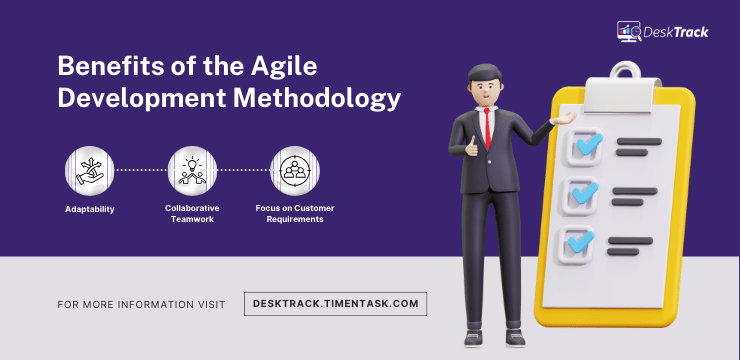
So we already know that the Agile methodology allows more flexibility and adaptability. However, that’s not all. Here are a few more reasons teams prefer this project management framework over others.
1. Adaptability
That’s the name of the game. This is the reason the said framework for managing projects is called Agile. The benefit here is that teams can quickly shift strategies without making the workflow go off track.
2. Collaborative Teamwork
As we mentioned before, as per the Agile methodology, face-to-face team communication is the most effective. Now, when we add the principle that says break the project silos to it, we end up having collaborative teamwork.
3. Focus on Customer Requirements
The aim is to create features, focusing on client requirements by collaborating with them. Furthermore, when those needs change, teams can switch to another project.
Limitations of Agile Development Methodology
As we mentioned before, there are some disadvantages of the said development framework and Agile methodology tools. To overcome these challenges and their impact, the best way is to use productivity monitoring software.
| Challenge | Impact |
| Unclear Timelines & Scope | Tough to predict deadlines and expenses. |
| High Stakeholder Involvement | Possibly causes burnout and decision fatigue. |
| Risk of Lost Details | Less documentation might lead to missing information. |
| Challenging to Scale for Large Teams | Complex to coordinate. |
| Requires Team Discipline | Self-managing teams usually have no focus and need managers to additionally oversee their work. |
Types of Agile Methodologies
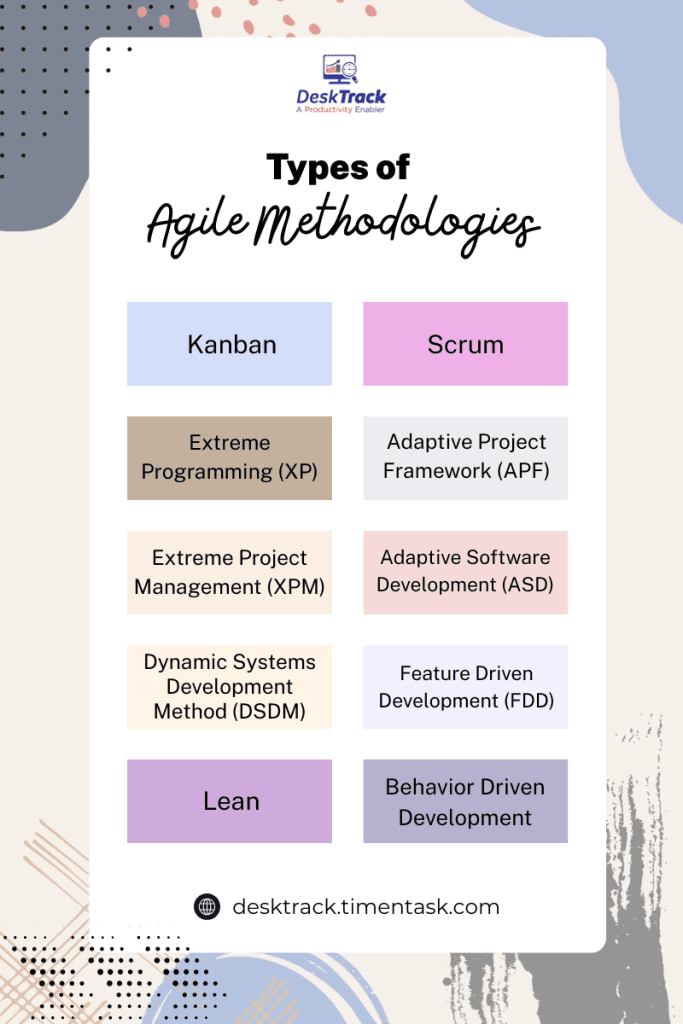
The Agile methodology in project management is an umbrella holding several variations of the framework. Below, we have compiled some of the most commonly used ones.
1. Kanban
Kanban is a visual framework where Kanban boards are the Agile methodology tools to present where the tasks are in the process. Here, fields are stages, and cards on the board are tasks. As the work moves forward, employees move the cards from the backlog to the correct stage.
2. Scrum
Scrum is for small teams and involves sprints. The team controller is called the Scrum master, who gets rid of all obstructions for the daily workers. There are daily meetings to discuss active tasks, forks on the road, and everything else that comes in between.
- Sprint Planning: It blueprints what and how we can work on things.
- Sprint Retrospective: You can say it’s a review of the sprint. The aim is to think about the learnings from the previous sprint to enhance and optimize the next one.
3. Extreme Programming (XP)
This framework is typically for usage in software development. XP highlights all 5 values that will let your team work more effectively together, including:
- Communication
- Simplicity
- Feedback
- Courage
- Respect
4. Adaptive Project Framework (APF)
APF or adaptive project management (APM) is built around the fact that unknown factors can change the workflow at any time in the project. Mainly used for IT projects, it focuses on the resources that you have instead of the ones that you require.
5. Extreme Project Management (XPM)
When projects are very complex and have a high level of uncertainty, XPM saves the workday. Extreme Agile methodology project management involves constantly adapting processes until you achieve the desired outcome. Plus, be ready to be flexible and experience short sprints that last only a few weeks at max when implementing this framework.
6. Adaptive Software Development (ASD)
If the project requires you to quickly adapt to changing needs, then go for ASD. With the main concentration on continuous adaptation, its speculation, collaboration, and learn stages let your teams learn along with the project progress.
7. Dynamic Systems Development Method (DSDM)
This framework focuses on the complete project lifecycle. For the same reason, it has a more rigorous base and structure, having these 4 primary stages.
- Business study and feasibility
- Prototype iteration or functional mode
- Build and design iteration
- Implementation
8. Feature Driven Development (FDD)
This framework blends all the varying best Agile practices. Although it’s still iterative, it prioritizes the exact features that your teams are working on. FDD heavily depends on client input, as the features focused on are the ones that the consumer requires.
9. Lean
Inspired by Toyota’s Lean manufacturing standards, it applies the same methodology in software development and business operations:
- Getting rid of anything that adds no value to the project.
- Quicker feedback loops.
- Team empowerment.
- Figuring out better ways to develop value.
10. Behavior Driven Development
The idea here is to bring together non-technical human resources to make the system’s technical functionality. Thus, it uses the universal language concepts, motivating collaboration between your tech and non-tech employees in the software project.
To make it even better, use time tracking software to automatically track how your employees are utilizing the resources (hours) available in these frameworks and increase focus.
Read Also: How Many Work Hours in a Year: A Complete Guide
Agile Methodology Vs. Traditional Project Management
Here’s how the Agile methodology compares to traditional project management approaches.
|
A strict step-by-step process. You must end each stage before the following part initiates. Overall, it works best for projects with stable needs. |
|
Subdivides projects into smaller, repeatable stages. Teams develop, test, and continuously adjust. Clients are always in the loop across the project lifecycle and can change the track at any time based on feedback and new priorities. |
Agile in Different Projects
The said framework has many use cases, including software development, marketing campaigns, event planning, and product development. Primarily because of the complex behavior of these projects.
1. Software Development
Software builders code high-quality products quickly by working in short, flexible cycles. As always, teams regularly build, test, and launch updates, utilizing client feedback to drive enhancements. This way, there will be 6 phases, including:
- Concept: Jot down the limitations and priorities of the project.
- Inception: Build teams having agility according to project needs.
- Iteration: Write the code, accounting for customer feedback.
- Release: This is the code testing and issue troubleshooting phase.
- Maintenance: You also need to provide ongoing tech support to your clients, ensuring that the product remains serviceable.
- Retirement: This is where the product lifecycle ends, frequently concurring with the next one.
2. Marketing Campaigns
Teams break campaigns into sprints to simplify repetition. There is a simple task board for keeping everyone focused on what’s next, while daily clock-ins assist in unblocking tasks.
3. Event Planning
Teams partition work into several sections, such as planning, vendor booking, and logistics. They even review progress per week. An advantage here is that if a new idea emerges or a vendor opts out, real-time team adjustment is possible without waiting for a long planning cycle to end.
4. Product Development
Again, teams work in short, focused cycles. The approach here is for the employees to make early prototypes, conduct user testing, and perform feedback-based design refinement. The method decreases expensive reworks, ensuring products meet client expectations before mass production.
Steps to Implement Agile Methodology Into Your Project
So, how can you apply the right agile methodology for project management in your work? Fortunately, it is very simple and only takes 5 steps.
1. Select the Right Framework
The wise thing to do is to choose the variation as per the requirements of your project. Plus, selecting a framework that your employees can easily adapt to and your team size is also key.
2. Arrange Your Team
Based on all the things you highlighted, you need to bring together all the required human resources and make your Agile team.
3. Plan the Project
The next step is to use the best strategic planning software to properly map out that perfect project plan.
4. Manage Stakeholder Expectations
Now, as per the 12 principles and 4 pillars we discussed earlier, you need to properly manage client and stakeholder expectations, flexibly adapting to feedback and shifting strategies as per the requirement changes.
5. Measure Success
Use standups (not comedies), reviews, and retrospectives to measure success. Also, you need to have KPIs to measure work quality against. So, don’t forget these metrics as well.
DeskTrack: The Better Way to Manage Your Projects
Seeing the limitations of the Agile methodology, you might be looking for something to fill those gaps. DeskTrack provides you with an all-in-one solution for success in all projects, while easily adapting to any project management approach.
- Unlimited Work Subdivisions: Subdivide your work into unlimited projects, workspaces, workflows, tasks, lists, and subtasks. You can easily assign users to subtasks and tasks for real-time tracking and even add any documents to your workspace for reference.
- Real-Time Progress Tracking: You will get real-time updates as the project progresses and task statuses change.
- The Simplest Workflow Management: Move tasks from one workflow to another within a few seconds. Managers can see these updates in real-time.
Additionally, you get the best employee monitoring, workforce management, and time tracking features with DeskTrack from a single platform for your remote, fieldwork, in-office, and hybrid teams for a complete 360 business activity monitoring solution. Try now and discover why businesses across 100+ countries have implemented the tool already.
Frequently Asked Questions (FAQ)
Q. What is Agile Methodology?
Ans. The Agile methodology of project management is a framework that divides projects into a plethora of effective stages, typically known as sprints. Simply put, it’s an iterative methodology because after every sprint, teams turn back and analyze if there was anything to improve, which helps adjust strategies for the next iteration.
Q. What is the Agile Manifesto?
Ans. Simply put, the document that compiles the 12 standards and 4 pillars of Agile is known as the Agile Manifesto.
Q. What are the Benefits of Implementing Agile Project Management?
Ans. You will experience these advantages.
- Adaptability
- Collaborative Teamwork
- Focus on Customer Requirements
Q. How Many types of Agile Frameworks Exist?
Ans. We have shortlisted the 10 most common Agile variations for you.
- Kanban
- Scrum
- Extreme Programming (XP)
- Adaptive Project Framework (APF)
- Extreme Project Management (XPM)
- Adaptive Software Development (ASD)
- Dynamic Systems Development Method (DSDM)
- Feature Driven Development (FDD)
- Lean
- Behavior Driven Development
Q. How to Implement Agile for Your Projects?
Ans. You will need only 5 steps.
- Select the Right Framework
- Arrange Your Team
- Plan the Project
- Manage Stakeholder Expectations
- Measure Success



